Editor’s note: Updated September 2018.
Gated content is a surprisingly divisive subject. Some marketers claim you can’t have an online marketing strategy without it, while others say to avoid it like a plague.

That sort of hesitation is understandable. A few years back, everyone worried that gated content would be flagged as spam, that potential leads wouldn’t submit their information, and similar concerns. Yet despite all the hand wringing, gated content hasn’t disappeared into the internet ether. In fact, it can be a pretty good way to find leads and push people through the sales funnel.
Interested? Let’s jump right in and see what gated content is all about.

To put it short and simple: Gated content is used to capture leads.
The term includes any high-end asset that you shield behind a barrier – usually a simple form – before sharing it with readers. Users will have to input some form of information before accessing your content.
Most forms will simply ask for the reader’s name and email address, but others will ask for other demographic data to help marketers segment readers into different groups. Such details usually include location, company size and/or job title. Longer forms require a bit more input on behalf of the user, but they help you better understand that person’s intent and decision-making power.
We’ll delve more into form best practices in a bit, but first we have to answer an important question: Why would readers give you their contact information in exchange for gated content when your blog posts are free?
Gated content: Using your best assets to generate leads
Here’s the thing: Gated assets aren’t blog posts. They’re better than blogs. They’re your most valuable pieces of content that are chock-full of facts, data and thought leadership. They’re the Artisan du Chocolat to your blog’s Hershey’s Kisses: higher quality and worth a premium.
As such, they’re a very useful tool for lead generation. The new contact details you get from your gated content are high-quality prospects. You know they’re interested in your product, and the asset they download or the responses in their form clue you into their intent.
This, of course, means you should save your best ingredients (assets) for your gated content. The following content types are naturally more thorough or in depth than blog posts, so your audience probably won’t mind handing over their email address for them:
- Ebooks
- White papers
- Webinars
- Research/studies
Now, there are two other types of content that you might want to gate depending on your marketing goals: case studies and infographics. I’ve seen people hide these behind form fills before, but I suggest keeping them open and easy to access. Case studies serve as reviews or testimonials for your brand, and while a good case study contains in-depth details and powerful metrics, they may not be compelling enough to convince a reader to fill out a form.
Meanwhile, infographics are so easily consumed that readers will want more in exchange for their contact info – more bang for their buck, so to speak.
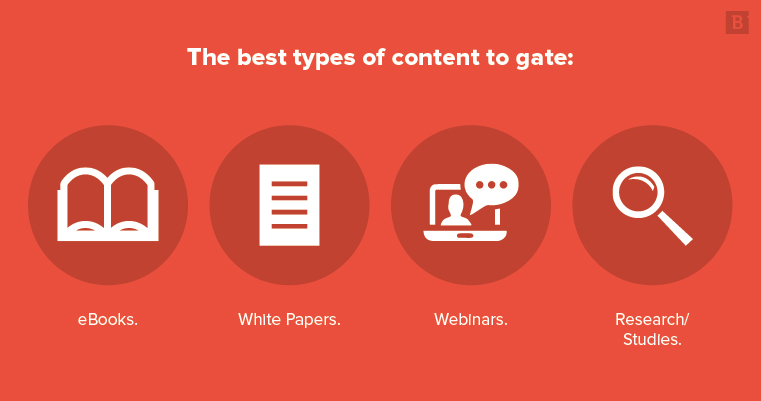
So, back to the topic at hand. If you restrict access to your best content only to people willing to give their email address in exchange, well, you’ve got a good list of qualified leads to add to your email marketing strategy. Pass this information to your sales team, and you might just find yourself with a new customer.
That’s the other great thing about gated content: People who download these assets are expressing a high level of interest in your product or service. They’re toward the middle or end of their buyer’s journey and looking for something that will push them over the edge.
That said, not everyone who downloads one of your gated assets is ready to buy. They’re close, but they aren’t quite there, and they may even choose a competitor in the end. That’s okay – these people aren’t gone forever. You still have their email address, so you can add them to a targeted mailing list designed to incentivize purchases and sway customers away from your competitors. Sometimes, a simple follow-up email is all you need to re-engage your potential customers.
Now, there are some drawbacks to be aware of. One, of course, is that gating your content limits its reach. Seems a bit odd to create The Greatest Piece of Content Ever, then lock it behind a form, doesn’t it? Second, Google can’t crawl content that’s behind a gate, so your content won’t bring any leads through search.
There are workarounds for each of these situations that we’ll get to in a bit. For now, just know that the positives to gated content can outweigh the negatives.

Where to gate your content
Based on everything said so far, you may be tempted to gate every piece of content on your website. But slow down: Gated content only works if customers have already evaluated your brand. If they don’t know who you are, what you do or how you could be useful, they certainly aren’t going to give you their email address.
Instead, create an inbound marketing strategy where your gated content falls toward the middle or bottom of your sales funnel. This gives new visitors a chance to explore your company and get a taste of your free content via blogs and social media posts. Make sure you have plenty of accessible high-quality content to lure people to the gated stuff.
Now, let’s return to those two drawbacks: limited reach and SEO. Solving these issues requires a more literal interpretation of “where to gate your content,” and the answer is “on a search-optimized landing page that you share on Twitter, LinkedIn, in a press release or other outlet.” This way, Google can still send you users searching for specific key terms. Furthermore, your audience can share links to this landing page across their social profiles. (You might be surprised how many landing pages I see in Buzzsumo that have very high shares.)
An optimized landing page will do wonders for your inbound marketing strategy, bringing leads right to your door and enticing them with detailed, long-form content. They may take a peek at your other web pages first, but they know that this specific landing page is where they can go to have their burning questions answered.
Separate pages versus emails with download links
Once your readers fill in their contact information and hit “Submit,” they expect to get direct access to your content. You can either send them to a new page hosting the document, or you can email them a link containing a downloadable version. Each have their advantages and disadvantages (separate pages are easy for readers to share outside of the gate and can cost you leads, but the separate step that email requires could affect engagement).
Teasing assets outside the gate
A good landing page for your gated content is a must have, but you also need to think about user intent. Your search traffic may not be as far down in the sales funnel as some of your other readers, and they might leave if they come across any barrier to the information they want. Not good at all: No one wants a landing page to a gated asset with a high bounce rate.
This is a great argument for posting some, but definitely not all, of the information in your asset somewhere outside of the gate. I’ve seen this a lot with research papers. Businesses will highlight a particular fact discovered in the study, then create a blog post about it with a call to action linking to the gated asset’s landing page.
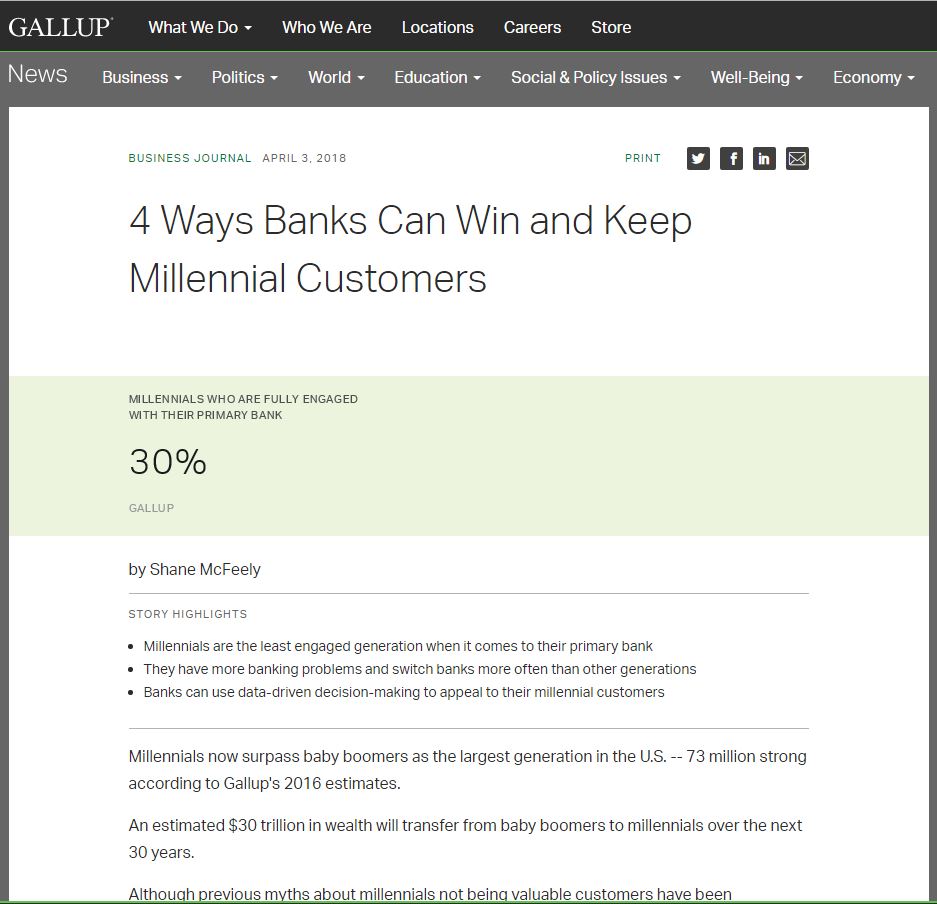
One of the first few links on this page takes readers to the report where the statistic “30 percent of millennials are fully engaged with their primary bank” was found:
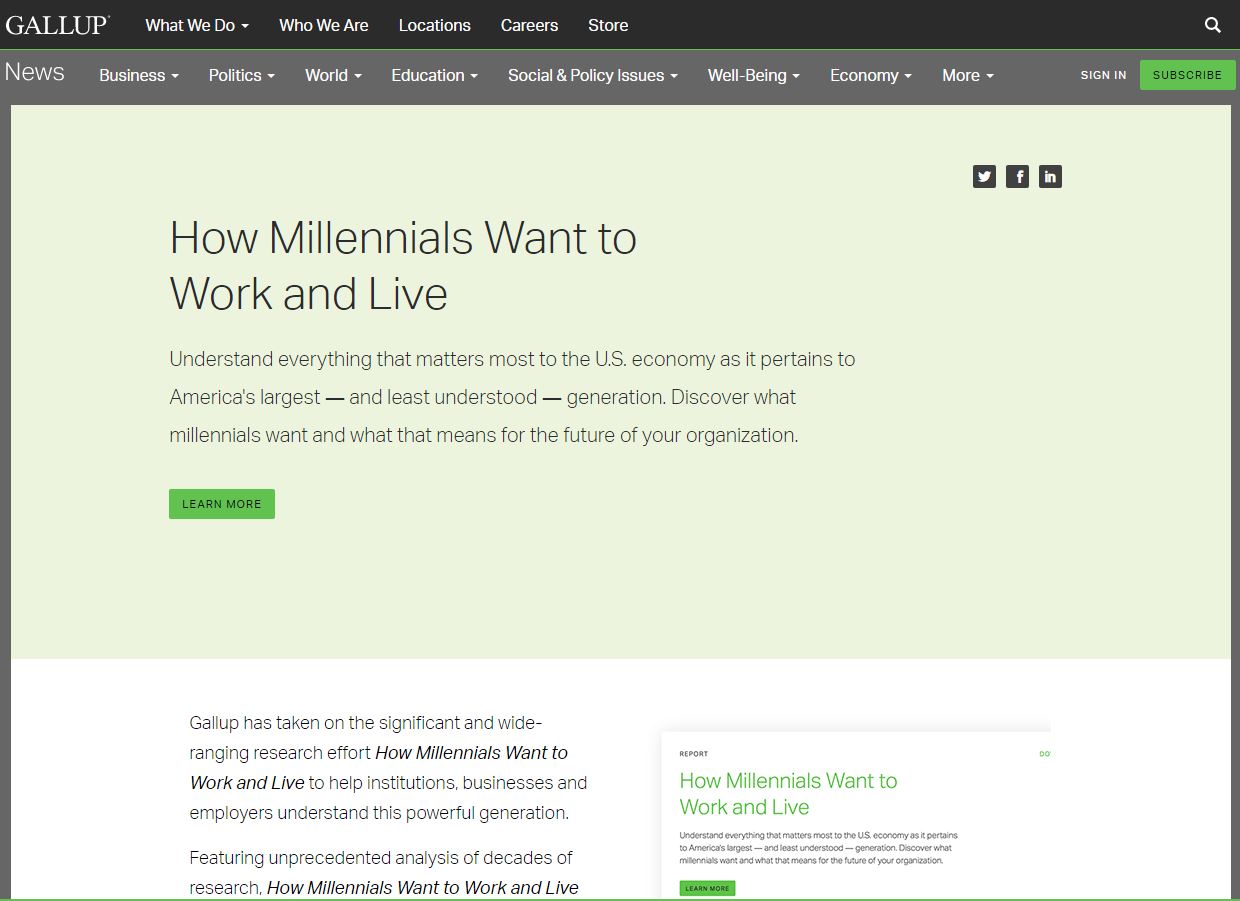
Another way to tease your content is to summarize certain facts in a shareable infographic. Don’t give everything away, but feature a few interesting highlights to show users the value they’d get if they downloaded the full thing.
Best practices for capturing leads with gated content
Information to ask for
You need a name and email address at minimum so that you can contact your reader (and so you know how to address them). However, you can also request a lot more details:
- Website.
- Company name.
- Company size.
- Industry.
- Job title.
- Phone number.
- LinkedIn.
I’ve even seen forms asking readers what their budget is.
Now, you may not want to include all of these fields, and there’s even a good argument for not including any of them. The first is privacy; people are more skeptical than ever about the information they provide online, regardless of who they’re handing it over to. To put minds at ease, include a privacy disclaimer at the bottom of your form near the call to action.
The second is fatigue. People don’t like filling out long forms online, and many case studies show that cutting a few questions can increase conversion rates dramatically. Just make sure you keep the important questions and consider the context.
So, if longer forms can end up turning readers away, why do some companies use them? Marketing purposes, of course. Knowing your readers’ job titles, industry and company size tells you a lot about who they are and why they downloaded your asset. Are they a decision maker who can sign off on a purchase (indicated by the job title)? Will they need several licenses for your software (you can guess by the company size)? This provides more context for when you get in touch with the individual and gives you a glimpse as to the interests of people who read your gated content.
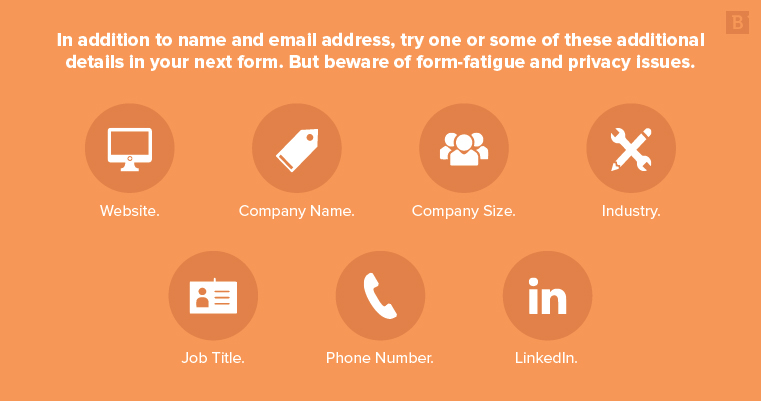
As you might guess, there’s no perfect answer to the question, “How many fields should my form have?” It depends on which outcome – comprehensive customer profiles or better user experience – is best for your marketing strategy.
Avoiding fake details
There’s no denying it: One of the not-so-savory things about gated content is the fact that users can put whatever they want into the contact information section, meaning your resulting leads aren’t as accurate as you might think.
- Use the correct input type. HTML5 lets you designate form fields with the email input type. This means the field will then scan the user-entered data to make sure everything is formatted like an email address. While this doesn’t help you spot fakes, it does prevent readers from entering something like “ASDFJKL.” You can do the same for numbers, dates and other details.
- Set a minimum length. While it’s possible that you have a reader with a single letter for a last name, it’s highly unlikely. Add a minimum length to your form fields so users can’t identify themselves as Mr. A B (of the famous B clan).
Filtering leads into your marketing automation software
Once you’ve got the customer’s contact information, you can use your marketing automation tool to deliver personalized messages without the hassle. Use the fields on your form to segment these emails however you wish – location, company size or other metric. This will help you create and deliver more relevant emails to your audience.
If you included an opt-in for additional marketing materials on your gated form, your marketing automation software can add these leads to your other mailing lists. Getting consent does two things:
- Appeals to your potential customers, as they won’t be automatically sent marketing messages they might not want.
- Helps you collect data on user intent and gives you an idea of how well your content resonates.
Should you gate your content?
Again, different people will give you various answers. Some would say this strategy is dying a slow death thanks to changing consumer preferences and email filters that send all marketing messages to spam.
That said, the promise of simple leads is almost too great to ignore. Here’s a two-step approach to see if you should gate or not gate:
- If your primary KPIs are quality leads and a larger list of contacts, then gated content can be useful.
- On the other hand, if your goals are brand awareness, reach and audience size, focus primarily on ungated content.
You can also mix and match your strategy, keeping the bulk of your content open and gating a select few assets.
Here are some last-minute things to remember:
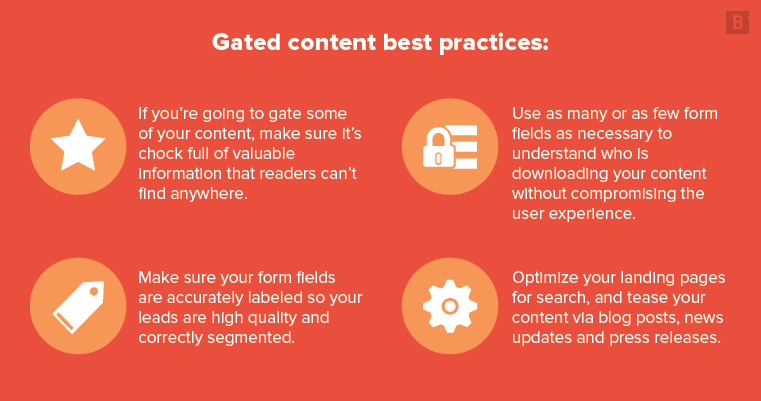
- If you’re going to gate some of your content, make sure it’s chock full of value information that readers can’t find anywhere.
- Use as many or as few form fields as necessary to understand who is downloading your content without compromising the user experience.
- Make sure your form fields are accurately labeled so your leads are high quality and correctly segmented.
- Optimize your landing pages for search, and tease your content via blog posts, news updates and press releases.
They key to gated content is balance. Provide enough for free that readers grow curious about what’s behind the gate. Create a form that captures just enough information but isn’t too long.
Thoughts? Which side of the argument do you fall on, or do you see both sides?






